

Violence obstétricale : émergence d'un problème public en France. Luttes féministes autour du consentement. Accompagner la naissance. La grossesse et l’accouchement sont aujourd’hui hautement médicalisés, ponctués de visites régulières chez les professionnels, marqués par une surveillance technique poussée et par un processus éducatif spécifique des futurs parents.
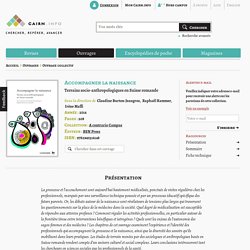
Or, les débats autour de la naissance sont révélateurs de tensions plus larges qui traversent les questionnements sur la place de la médecine dans la société. Quel degré de médicalisation est susceptible de répondre aux attentes profanes ? Comment réguler les activités professionnelles, en particulier autour de la frontière ténue entre interventions bénéfiques et iatrogènes ? Quels sont les enjeux de l’autonomie des sages-femmes et des médecins ? Les chapitres de cet ouvrage examinent l’expérience et l’identité des professionnels qui accompagnent la grossesse et la naissance, ainsi que la diversité des savoirs qu’ils mobilisent dans leurs pratiques.
Page 1 à 4. Prise en charge de la douleur chez la femme pendant le travail - vue d'ensemble. Chez les femmes, l'expérience de la douleur varie sensiblement pendant le travail.
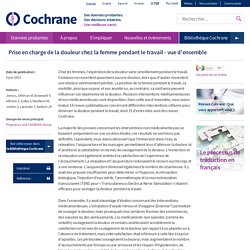
Certaines ne ressentent quasiment aucune douleur, alors que d'autres ressentent une douleur extrêmement pénible. La position de la femme pendant le travail, sa mobilité, ainsi que sa peur et son anxiété ou, au contraire, sa confiance peuvent influencer son expérience de la douleur. Plusieurs interventions médicamenteuses et non médicamenteuses sont disponibles. Hémorragies après l’accouchement : quel rôle pour l’ocytocine ? 13 février 2012 Vous avez travaillé sur le risque d’hémorragie post-partum, c’est à dire après l’accouchement.

Médiathèque. CHARPAK N., TESSIER R.

& al. Pediatrics. 2016 Dec 12. pii: e20162063. décembre 2016 Moore ER, Bergman N, Anderson GC, Medley N. Cochrane Database Syst Rev. 2016 Nov 25;11:CD003519. Évolution de la fonction obstétricale chez les hominoïdes : analyse morphométrique tridimensionnelle de la cavité pelvienne chez les espèces actuelles et fossiles. Thèse de doctorat en Paléontologie humaine Résumé La cavité pelvienne est le lieu de passage du fœtus lors de l’accouchement.
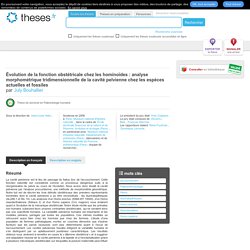
Cette fonction naturelle est considérée comme un processus dangereux suite à la réorganisation du pelvis au cours de l’évolution. Nous avons donc étudié la cavité pelvienne par l’analyse procustéenne, une méthode de morphométrie géométrique. Notre but est de décrire les trois détroits obstétricaux des premiers représentants hominidés dont la cavité pelvienne a pu être reconstituée : les Australopithèques (AL288-1 et Sts 14).
Les analyses d’un Homo erectus (KNM-WT 15000), d’un Homo neanderthalensis (Kébara 2) et d’un Homo sapiens (Cro magnon) nous éclairent quant à l’évolution de la mécanique obstétricale. “Is it realistic?” the portrayal of pregnancy and childbirth in the media. Much of the literature in this scoping review fell into a category of media-effects research that suggests that audiences do not critically engage [16].

This ‘hypodermic needle approach’ to media research is based on behavioural-effects theory that tends to rely on a basic understanding of cause-and-effect and assumes that all media audiences are passive. Such studies frequently utilize strongly challenged, if not discredited, theories of direct or causal media effects, which can be problematic because they fail to take into consideration more recent and critical approaches to audience research. One key issue with audience reception is that is not easily observable, except in fragmentary or indirect ways [54].
A Secondary Analysis of Mistreatment of Women During Childbirth in Health Care Facilities. Women’s descriptions of childbirth trauma relating to care provider actions and interactions. Psychological and somatic sequelae of traumatic vaginal delivery: A literature review. Obstetric violence: Medicalization, authority abuse and sexism within Spanish obstetric assistance. A new name for old issues? Master thesis, Faculty of Humanities Theses, Utrecht University.
Database - Alliance francophone pour l'accouchement respecté (AFAR) New expert query --- New simple query Creating new record This database is managed by Alliance francophone pour l'accouchement respecté (AFAR, with Collectif interassociatif autour de la naissance (CIANE, is fed by the voluntary contributions of persons interested in the sharing of scientific data.If you agree with this project, you can support us in several ways:(1) becoming a member of AFAR(2) financially supporting AFAR(3) contributing to this database if you have a minimum training in scientific documentation.
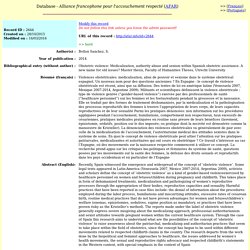
A systematic review of maternal confidence for physiologic birth: characteristics of prenatal care and confidence measurement. Caregiver support for women during childbirth. Human rights in childbirth, narratives and restorative justice: a review. Human rights in childbirth is an emerging field within reproductive health rights.
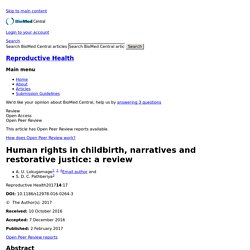
The Millennium Development Goals of the United Nations (UN) have drawn to a close and so far there had been a focus on improving maternal health within the context of improving access to facility based healthcare, but what is becoming clearer is that this alone is not sufficient [1, 2]. Although the previous focus has been the equal and fair access to healthcare, there is now a greater recognition of the importance of dignity, respect and autonomy for women who do utilise healthcare facilities [3]. The FREDA principle, is a useful human rights summary of the core issues at stake - fairness, respect, equality, dignity and autonomy [4]. The new UN Sustainable Development Goals are far more rights based. Human rights in the global birthing arena Women who receive care from factory line conditions within health facilities are experiencing disrespect and abuse worldwide.
Birth interventions related to lower rates of exclusive breastfeeding. Download Article: Download (PDF 2,195.3 kb) Abstract: Overview: This study examines the impact of birth interventions, such as epidurals, inductions, pain medications, and cesarean sections, on breastfeeding and postpartum depression with a large sample of mothers.
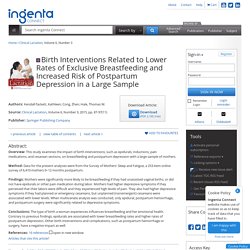
Method: Data for the present analyses were from the Survey of Mothers' Sleep and Fatigue, a 253-item online survey of 6,410 mothers 0–12 months postpartum. Findings: Mothers were significantly more likely to be breastfeeding if they had unassisted vaginal births, or did not have epidurals or other pain medication during labor. A comparison of intrapartum interventions and adverse outcomes by parity in planned freestanding midwifery unit and alongside midwifery unit births: secondary analysis of ‘low risk’ births in the birthplace in England cohort. The Birthplace cohort included 27,992 eligible ‘low risk’ women planning birth in an FMU or AMU.
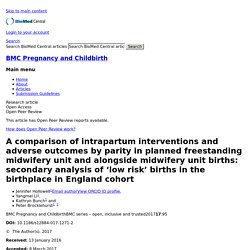
The population for this analysis consisted of 27,938 ‘low risk’ women with known parity: 11,265 planning birth in an FMU and 16,673 planning birth in an AMU. Fifty four births were excluded because parity was unknown. The Mothers on Respect (MOR) index: measuring quality, safety, and human rights in childbirth. Beyond too little, too late and too much, too soon: a pathway towards evidence-based, respectful maternity care worldwide. On the continuum of maternal health care, two extreme situations exist: too little, too late (TLTL) and too much, too soon (TMTS).
TLTL describes care with inadequate resources, below evidence-based standards, or care withheld or unavailable until too late to help. TLTL is an underlying problem associated with high maternal mortality and morbidity. Midwifery and quality care: findings from a new evidence-informed framework for maternal and newborn care. To view the full text, please login as a subscribed user or purchase a subscription.
Click here to view the full text on ScienceDirect. Figure 1 Diagram of the multimethod approach used in this study Figure 2. The power of midwifery. Meeting needs of childbearing women and newborn infants through strengthened midwifery. Nature works best when allowed to run its course. The experience of midwives promoting normal births in a home birth setting. Early skin-to-skin contact for mothers and their healthy newborn infants. Plain language summary Early skin-to-skin contact for mothers and their healthy newborn infants What is the issue?
Babies are often separated from their mothers at birth. In standard hospital care, newborn infants can be held wrapped or dressed in their mother’s arms, placed in open cribs or under warmers. In skin-to-skin contact (SSC), the newborn infant is placed naked on the mother's bare chest at birth or soon afterwards. Why is this important? There are well-known benefits to breastfeeding for women and their babies. What evidence did we find? We searched for randomized controlled studies of immediate and early SSC on 17 December 2015. Women giving birth by cesarean may benefit from early SSC, with more women breastfeeding successfully and still breastfeeding at one to four months (fourteen studies, 887 women, moderate-quality evidence), but there were not enough women studied for us to be confident in this result. What does this mean? Резюме на простом языке В чем суть проблемы? 平易な要約 論点 訳注. Electronic fetal monitoring, cerebral palsy, and caesarean section: assumptions versus evidence.
Karin B Nelson, scientist emeritus1, Thomas P Sartwelle, attorney2, Dwight J Rouse, academic obstetrician3Author affiliationsCorrespondence to: K B Nelson nelsonk@ninds.nih.gov Given evidence that cerebral palsy is not reduced by electronic fetal monitoring, Karin Nelson, Thomas Sartwelle, and Dwight Rouse ask why routine monitoring and related litigation continue to contribute to high rates of caesarean births.
Association of peripartum synthetic oxytocin administration and depressive and anxiety disorders within the first postpartum year. The meaning of labour pain: how the social environment and other contextual factors shape women’s experiences. The majority of women experience pain during labour and childbirth. For many women it is the most significant pain they will experience in their life. A randomised controlled trial in comparing maternal and neonatal outcomes between hands-and-knees delivery position and supine position in China.
Comparing the effects of spontaneous pushing versus Valsalva pushing technique on outcome of delivery in primiparous women - Journal of Shahrekord University of Medical Sciences - مجله دانشگاه علوم پزشکی شهرکرد. A meta-analysis of passive descent versus immediate pushing in nulliparous women with epidural analgesia in the second stage of labor. Objective: To determine which method of pushing—passive descent or early pushing—most benefits women with epidurals during second-stage labor. Data sources: MEDLINE, CINAHL, and Cochrane Database. Study selection: Studies limited to randomized controlled trials in English, comparing passive descent to early pushing in women with effective epidural analgesia. Data extraction: A hand search was performed. Data included number of instrument-assisted deliveries (forceps and vacuum); noninstrumental or spontaneous vaginal births, cesarean births, pushing time, episiotomies, lacerations; maternal fatigue; and fetal well-being.
Is routine use of episiotomy justified? Birth position and obstetric anal sphincter injury: a population-based study of 113 000 spontaneous births. For centuries, pros and cons about different birth positions have been debated. For upright labour, several physiological advantages have been hypothesized and measured, such as effects of gravity, stronger uterine contractions, maternal satisfaction and feeling of control [1, 2, 3]. However, today the majority of women in the Western societies deliver in a dorsal, semi-recumbent/sitting or lithotomy position [4, 5, 6, 7]. It is claimed that these positions enable the attending midwife or obstetrician to monitor the fetus and facilitate a hands-on approach to perineal management to lower the risk of obstetric anal sphincter injuries (OASIS) [8].
Obstetric anal sphincter injuries are related to long term maternal complications, such as anal incontinence [9, 10, 11], sexual dysfunction [12], pain [13] and a reduced quality of life [14, 15, 16]. Episiotomy for vaginal birth. Plain language summary Episiotomy for vaginal birth Vaginal tears can occur during childbirth, most often at the vaginal opening as the baby's head passes through, especially if the baby descends quickly. Selective versus routine use of episiotomy for vaginal birth. Abstract Background. Relationship of episiotomy to perineal trauma and morbidity, sexual dysfunction, and pelvic floor relaxation. Long-term childhood outcomes of breech presentation by intended mode of delivery: a population record linkage study - Bin - 2016 - Acta Obstetricia et Gynecologica Scandinavica.
Introduction There is a lack of information on long-term outcomes by mode of delivery for term breech presentation. We aimed to compare childhood mortality, cerebral palsy, hospitalizations, developmental, and educational outcomes associated with intended vaginal breech birth (VBB) compared to planned cesarean section . What is the best treatment to reduce the need for caesarean section in nulliparous women at term with delayed first stage of labour? Pregnant women who smoke: a challenge to the patient-physician relationship. Ms. Davis had many attributes that suggested she would become a successful parent. She was pleased with her current career position, had a strong support network of friends and family, and enjoyed a healthy relationship with her partner. She began prenatal care early in her pregnancy and was now at 20 weeks. The pregnancy had a single complication. Evaluation of the Bonapace method. Making home birth even safer for mothers and babies.
Abstract: Nursing frequency, gonadal function and birth spacing among !Kung hunters-gatherers. Enabling breastfeeding for mothers and babies. When Evidence Says No, but Doctors Say Yes. What conclusions has Clinical Evidence drawn about what works, what doesn't based on randomised controlled trial evidence?